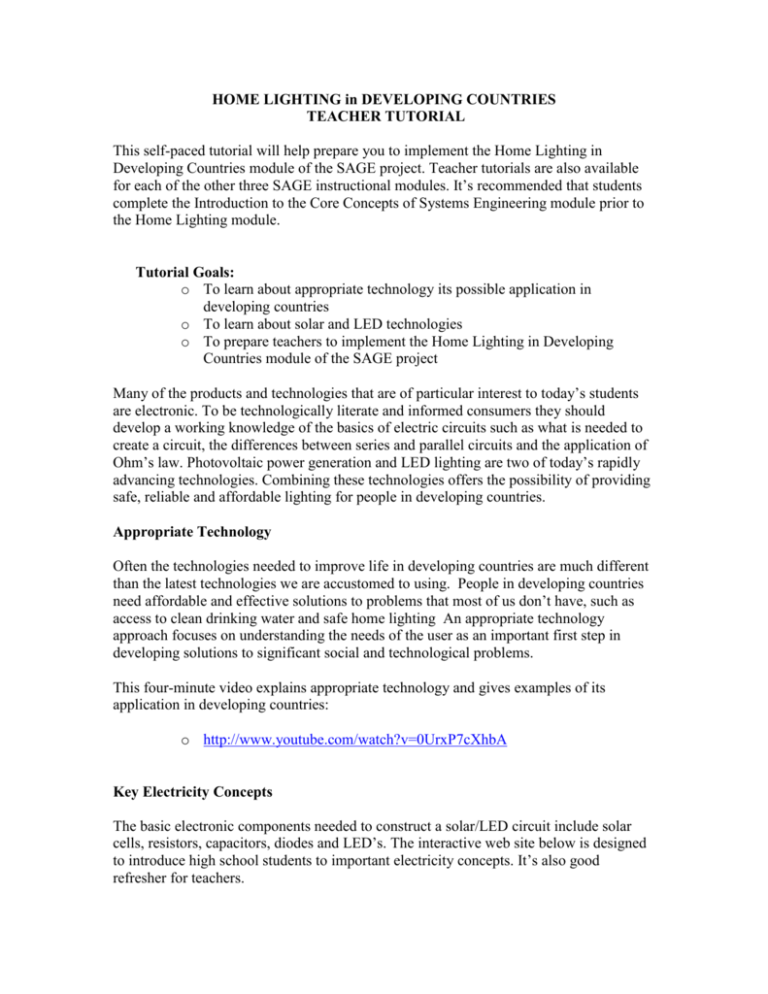home lighting teacher tutorial
advertisement

HOME LIGHTING in DEVELOPING COUNTRIES TEACHER TUTORIAL This self-paced tutorial will help prepare you to implement the Home Lighting in Developing Countries module of the SAGE project. Teacher tutorials are also available for each of the other three SAGE instructional modules. It’s recommended that students complete the Introduction to the Core Concepts of Systems Engineering module prior to the Home Lighting module. Tutorial Goals: o To learn about appropriate technology its possible application in developing countries o To learn about solar and LED technologies o To prepare teachers to implement the Home Lighting in Developing Countries module of the SAGE project Many of the products and technologies that are of particular interest to today’s students are electronic. To be technologically literate and informed consumers they should develop a working knowledge of the basics of electric circuits such as what is needed to create a circuit, the differences between series and parallel circuits and the application of Ohm’s law. Photovoltaic power generation and LED lighting are two of today’s rapidly advancing technologies. Combining these technologies offers the possibility of providing safe, reliable and affordable lighting for people in developing countries. Appropriate Technology Often the technologies needed to improve life in developing countries are much different than the latest technologies we are accustomed to using. People in developing countries need affordable and effective solutions to problems that most of us don’t have, such as access to clean drinking water and safe home lighting An appropriate technology approach focuses on understanding the needs of the user as an important first step in developing solutions to significant social and technological problems. This four-minute video explains appropriate technology and gives examples of its application in developing countries: o http://www.youtube.com/watch?v=0UrxP7cXhbA Key Electricity Concepts The basic electronic components needed to construct a solar/LED circuit include solar cells, resistors, capacitors, diodes and LED’s. The interactive web site below is designed to introduce high school students to important electricity concepts. It’s also good refresher for teachers. http://www.ndted.org/EducationResources/HighSchool/Electricity/workwithelectricity.htm Reflection Questions: o What are the fundamental differences between series and parallel circuits? o Why is it important for students to understand series, parallel and series-parallel circuits as they prepare to construct solar/LED lights. Solar Solar yard lights are inexpensive and readily available. They can be disassembled by students and their components can be used as the basis as for constructing solar/LED prototype projects. Solar yard lights can also be used to teach about reverse engineering. Reverse engineering is the process of disassembling a product to discover how it’s made, what it is made from and how it works. You can learn more about reverse engineering from the Introduction to Core Concepts of Systems Engineering module and teacher tutorial (http://www.ciese.org/curriculum/seproject/index.html). Read: How Solar Yard Lights Work o http://www.howstuffworks.com/solar-light.htm Reflection: o How do the major electronic components (solar cell, resistors, LED’s, diodes and capacitors) work together in the basic circuit needed for a solar/LED lighting system? o If you have an opportunity, disassemble a solar yard light. Compare your yard light yard to the one described in the How Stuff Works article. How are they similar? How are they different? LED’s LED’s are an increasingly important source of lighting for automobiles, traffic signals, and commercial lighting. Home improvement stores are beginning to sell them for consumer applications. The online resource, How Stuff Works, has an article that explains how diodes work, the advantages of LED’s and links to other articles about LED’s and their applications. http://www.howstuffworks.com/led.htm LED’s Magazine (http://www.ledsmagazine.com/main) is an online magazine that focuses on describing innovation within the LED lighting industry. Each issue includes articles, news about new products and case studies that describe success stories and the challenges of using LED’s for new applications. Combining LED and Solar Technologies Light Up The World Foundation http://www.lutw.org/index.html The Light Up The World Foundation is an international organization whose mission is to provide renewable and appropriate energy to communities throughout the world that do not have access to affordable energy. Their web site provides up-to-date information about their current projects and products. Share this web site with students to help them understand how their projects have changed lives by allowing families to purchase food rather than spending money on batteries or candles. Final Reflection Think about how you will introduce your students to appropriate technology through an activity that introduces them to key electricity concepts as well as solar, LED and other contemporary technololgies.






